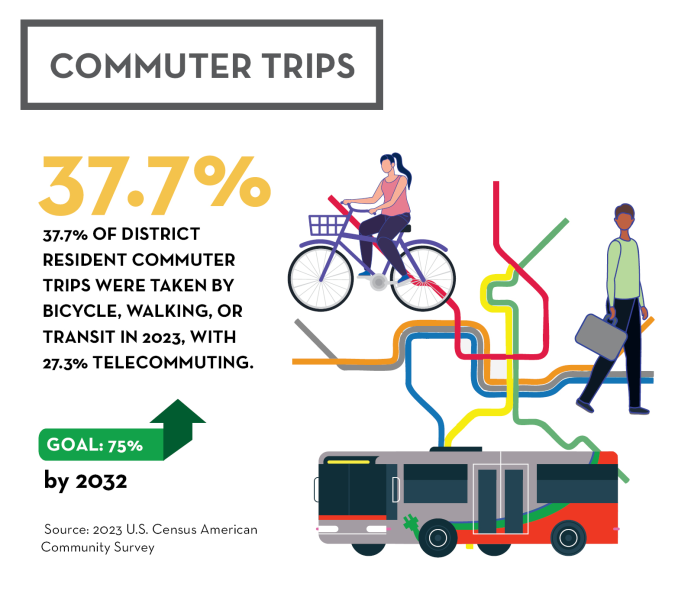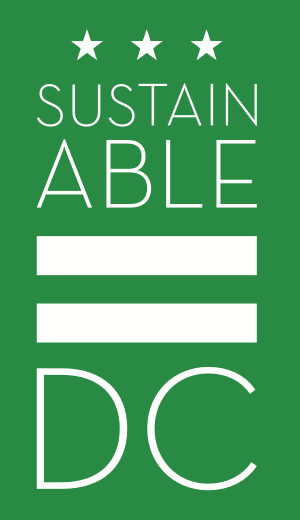

 The District's transportation system is critical for residents, visitors, and commuters who rely on it to get to work or school, go shopping, visit friends and family, or access essential services. While DC is in the top five most walkable and transit-friendly cities, and in the top ten bike-friendly cities in the U.S., according to Walk Score, some areas lack easy access to frequent, reliable public transportation or are so disconnected from city amenities that walking and biking are not viable transportation options. Furthermore, poorly designed or maintained infrastructure can prevent community members with varying physical abilities from efficiently getting around. In terms of its contribution to climate change, transportation is the second-largest source of greenhouse gas emissions in the District, driven predominantly by passenger vehicles’ fossil fuel use, as reported by the Department of Energy and Environment. To ensure a transportation system that is convenient, safe, clean, healthy, and equitable, the District Government must establish the infrastructure to make active transportation modes the convenient choice and eliminate emissions from the remaining necessary vehicle trips.
The District's transportation system is critical for residents, visitors, and commuters who rely on it to get to work or school, go shopping, visit friends and family, or access essential services. While DC is in the top five most walkable and transit-friendly cities, and in the top ten bike-friendly cities in the U.S., according to Walk Score, some areas lack easy access to frequent, reliable public transportation or are so disconnected from city amenities that walking and biking are not viable transportation options. Furthermore, poorly designed or maintained infrastructure can prevent community members with varying physical abilities from efficiently getting around. In terms of its contribution to climate change, transportation is the second-largest source of greenhouse gas emissions in the District, driven predominantly by passenger vehicles’ fossil fuel use, as reported by the Department of Energy and Environment. To ensure a transportation system that is convenient, safe, clean, healthy, and equitable, the District Government must establish the infrastructure to make active transportation modes the convenient choice and eliminate emissions from the remaining necessary vehicle trips.
Goal 1: Improve connectivity and accessibility through efficient, integrated and affordable transit systems
Status:  The average progress score of actions under this goal is between “Moderate Progress” (2 out of 4) and “Significant Progress” (3 out of 4). See annual progress reports for details.
The average progress score of actions under this goal is between “Moderate Progress” (2 out of 4) and “Significant Progress” (3 out of 4). See annual progress reports for details.
What's Been Done?
- Through the Washington Area Bus Transformation Project, coordinated action by both the District Department of Transportation and the Washington Metropolitan Area Transit Authority has resulted in bus queue jumps (methods to provide buses priority) in key intersections in DC, several permanent dedicated bus lanes, and transit signal priority corridors.
- The DC Streetcar began operations on H Street NE in 2016.
- The Washington Metropolitan Area Transit Authority introduced the Metro Lift Income-Qualified Program to provide reduced fare for customers that receive Supplemental Nutrition Assistance Program benefits and lowered rail fares on weekends instead of the previous distance-based .
- The Washington Metropolitan Area Transit Authority launched Clear Lanes, a partnership with the District, to enforce dedicated bus lanes and bus stop zones and provide faster and more reliable bus service for DC residents.
- In 2023, the Washington Metropolitan Area Transit Authority began 24/7 bus service on select routes in the District.
What is Left to Do?
- Expand high capacity transit on high ridership corridors.
- Improve transit connections to employment and activity centers from underserved areas.
- Develop design guidelines to ensure transit systems are resilient to climate change.
- Identify and remove the obstacles to families taking transit.
Goal 2: Expand safe, connected infrastructure for pedestrians and cyclists
Status:  The average progress score of actions under this goal is between “Moderate Progress” (2 out of 4) and “Significant Progress” (3 out of 4). See annual progress reports for details.
The average progress score of actions under this goal is between “Moderate Progress” (2 out of 4) and “Significant Progress” (3 out of 4). See annual progress reports for details.
What's Been Done?
- The District has more than 180 miles of bike lanes, more than 60 of which are protected bike lanes.
- The District Department of Transportation provides bike and pedestrian safety education through initiatives such as Safe Routes to School and initiated the Trail Ranger Program in 2013 to provide additional security and repair assistance along DC's trails.
- The District Department of Transportation maintains a system of more than 15 automated counters to measure the number of people walking and biking and their data is available publicly.
- The District Department of Transportation and DC Public Schools collaborate to make bikes available to 2nd graders so they learn how to ride.
- The District Department of Transportation has implemented hundreds of Leading Pedestrian Intervals throughout the District, which give pedestrians a few seconds to start crossing before vehicular lights change.
- More than 80% of District residents are within a quarter mile of a Capital Bikeshare station.
- The District Department of Transportation has four Districtwide contracts that are actively repairing sidewalks.
What is Left to Do?
- Develop and maintain a safe and convenient citywide bicycle lane and trail network.
- Increase bike, scooter and pedestrian safety education for drivers, cyclists, and pedestrians, and enforce laws protecting those who walk and use scooters and bicycles.
- Collect data to improve understanding of cyclist and pedestrian travel patterns.
- Program crosswalks and traffic lights for improved safety and convenience of pedestrians, prioritizing children, older adults, and people with disabilities.
- Ensure sidewalks are in good repair on at least 90% of District streets, prioritizing new sidewalk construction in pedestrian priority areas such as schools, parks, transit stops, and retail corridors.
Goal 3: Enhance affordable, convenient transportation options to reduce dependency on single occupant vehicles
Status:  The average progress score of actions under this goal is between “Moderate Progress” (2 out of 4) and “Significant Progress” (3 out of 4). See annual progress reports for details.
The average progress score of actions under this goal is between “Moderate Progress” (2 out of 4) and “Significant Progress” (3 out of 4). See annual progress reports for details.
What's Been Done?
- Organizations with 20 or more employees in the District of Columbia are required to offer commuter benefits to their employees such as setting aside pre-tax funds for transit.
- Organizations with 20 or more employees in the District of Columbia that offer a parking benefit (free, subsidized, or reimbursed parking) to their employees are required to offer a Clean Air Fringe Benefit to employees (such as a transit pass or direct cash), develop a transportation demand management plan, or pay a Clean Air Compliance fee.
- goDCgo, a program of the District Department of Transportation, encourages the use of sustainable transportation and regularly engages businesses on the Commuter Benefits Law and in competitions to promote cycling, carpooling, walking, and taking public transportation to work.
- The District Government has established policies on teleworking and alternative work schedules for its employees.
- The District finalized the California Advanced Clean Cars 2 regulation, which would phase-in percentages of light-duty vehicle registrations needing to have zero emissions, leading to 100% of light-duty vehicle registrations needing to be zero-emission vehicles by model year 2035.
What is Left to Do?
- Encourage carpooling and carsharing.
- Encourage private businesses to offer incentives to employees for transit, biking, and walking.
- Complete a study to understand the best strategies for reducing congestion for all without unfairly burdening residents with low incomes.
Goal 4: Reduce greenhouse gas emissions and air pollution from the transportation sector
Status:  The average progress score of actions under this goal is between “Moderate Progress” (2 out of 4) and “Significant Progress” (3 out of 4). See annual progress reports for details.
The average progress score of actions under this goal is between “Moderate Progress” (2 out of 4) and “Significant Progress” (3 out of 4). See annual progress reports for details.
What's Been Done?
- The Department of Energy and Environment has run multiple campaigns to address commercial vehicle idling hotspots and allows residents to report violations of the engine idling regulation.
- The Climate Commitment Amendment Act of 2022 requires that the District government purchases or leases only zero-emissions vehicles beginning in 2026 and that vehicle-for-hire companies submit greenhouse gas emission reduction plans.
- The Washington Metropolitan Area Transit Authority began incorporating zero-emission buses into its fleet.
What is Left to Do?
- Strictly limit idling engines.
- Require the District Government to purchase green fleet and passenger vehicles.
- Encourage network of electric vehicle charging stations throughout the city.
- Fully electrify District-controlled buses, and work with regional bus systems to reduce regional bus emissions.
Last updated: June 2025

